Wed 13 Nov 2013
A Book & Movie Review by David Vineyard: PAUL CAIN – Fast One / GAMBLING SHIP (1933).
Posted by Steve under Crime Films , Pulp Fiction , Reviews[4] Comments
GAMBLING SHIP. Paramount, 1933. Cary Grant, Benita Hume, Jack La Rue, Roscoe Karns, Glenda Farrell, Arthur Vinton, Marc Lawerence. Screenplay: Max Marcin, Seton I. Miller. Adaptation: Claude Binyon. Based on the serial “Fast One” appearing in Black Mask magazine by Paul Cain (Peter Ruric). Directors: Louis Gasnier and Max Marcin.
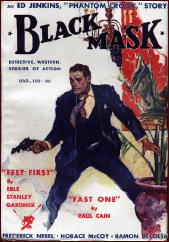
That passage from the Paul Cain novel is as close as this movie gets to the hardboiled classic it was based on, Fast One, though more than a bit of the basic plot is used — just not to the same effect as in the book.
How Fast One, a novel that was so terse and stacatto it made Hammett read like a Victorian triple decker, became this romantic dramedy with Cary Grant and Benita Hume is one of those mysteries only a Hollywood producer could explain — or justify — but that’s what happened on the classic Black Mask serial’s way to the big screen as Gambling Ship.
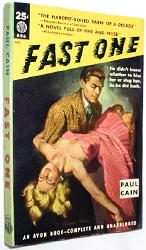
Gone are Gerry Kells, the tough as nails gambler and gunman, and Grandquist (Kells looked at the woman. She was blonde — but darkly, warmly. Her mouth was very red without a great deal of rouge, and her eyes were shadowed and deep. She was a tall woman with very interesting curves. Fay said: “This is Miss Granquist.â€), a femme fatale so fatal and tough she could give lessons to Hammett’s Diana Brand and Brigid O’Shaunessy as well as Chandler’s Velma, and in their place we have a tough but much smoother Cary Grant as Ace Corbin (replete with gray at the temples and a streak in his wavy dark hair), a New York gambler finding it hard to go straight and Benita Hume as the most lady like (if not entirely wholesome) moll you can imagine (well kept too, her apartment in Los Angeles has a bathroom the size of most bedrooms).
Gambling Ship opens in New York where the newspaper boys are hawking the extra that gambler Ace Corbin has just been acquitted of a murder charge, a fact that seems to amuse police and public alike:
Second Woman: “Yeah, but he kills people.”
First woman: “So does rheumatism.”
Kells has similar problems in the book:
“And at heart you’re just a big, sympathetic boy who wouldn’t hurt a fly.â€
“Uh, huh.†He nodded his head slowly, emphatically. His face was expressionless.
“Me — I’m Napoleon.†Granquist took a powder puff out of the bag and rubbed it over her nose.
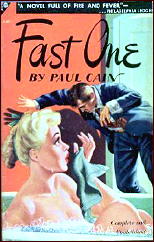
That pretty much sums up this semi-tough film that might be a dress rehearsal for one of Cary Grant’s later iconic roles as gambler Mr. Lucky. Here Ace Corbin is sick of New York and the rackets, and having walked from a frame set up by hood Pete Manning (Jack La Rue), all Corbin wants is to head to the coast and take a vacation.
Not so easy, as flunky Marc Lawerence points out when one of Ace’s men tosses Ace’s shoulder holster and gun in his bag: “Sometimes even a good man has to blast his way loose.”
It’s hard to imagine Kells having to be persuaded to “blast his way looseâ€:
On the train to the coast Ace meets beautiful society girl Eleanor Kiniston and a romance blossoms, Ace introducing himself as Bruce Grahame. Ace isn’t the only one with a secret. Eleanor is really Eleanor La Vere, girlfriend of Joe Burke (Arthur Vinton), a west coast gambler who runs an off shore casino.
Burke’s in a bind for money, thanks to his chief competitor hijacking his customers for his own ship, Pete Manning’s Paradise. Once home Eleanor finds out what a bind Burke is in, and being to noble to walk out on him drops Bruce.
Eleanor’s friend Jennie Sands (Glenda Farrell): “That’s the time to walk out.”
Meanwhile Burke’s henchman Blooey (Roscoe Karns) is an old friend of Ace, and tries to convince Ace to go in with Burke, a chance to buy into a good deal and take revenge on Manning, but Ace is in love and wants none of it.
Blooey: “Yeah, Ace always sends flowers.â€
But Manning won’t leave Ace alone so he agrees to go in with Burke. and starts by hijacking back all the players Manning hijacked in the first place.
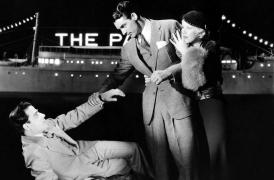
That does sound like Kells.
Again, this hews close to the novel:
His first night on the ship Eleanor shows up and finds out he’s Corbin, but he still thinks she’s a classy society woman, an illusion that will have to stay in place when Manning fire bombs the ship.
The ending is well done and exciting, and being pre-Code, neither Ace nor Eleanor have to repent or suffer for the error of their ways. A clinch, a kiss, and Ace is ready to turn that vacation into a honeymoon, assuming he still has marriage on his mind after finding out who she is. This being the pre-Code era, happily ever after didn’t always need a license and a justice of the peace. It’s a very different ending than Fast One.
Gambling Ship has a bad reputation among fans largely because it is based on Fast One, the legendary hardboiled extravagansa of flying bullets and McGuffey’s reader prose by screen writer Peter Ruric (The Black Cat, The Raven, Grand Central Murder …) writing as Paul Cain.
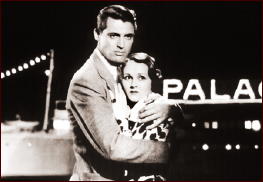
Granted it would have been nice to see his novel get the pre-Code treatment with Grant as tough-as-nails lethal gambler gunman Kells (though reading the book I always have Alan Ladd in mind), but that aside this isn’t a bad little film and like any decent pre-Code film (or is that indecent?) it’s interesting to note the little touches like the teasing dialogue bordering on double entendre, the suggestion of nudity (Hume outlined fairly clearly in a pebbled glass shower), skimpy lingerie (and not a lot of it), and a cavalier attitude to sex, without moralizing or due punishment, that could only be hinted at in later films.
To be fair, any movie that has both a journey on a train and a gambling ship can’t be all bad.
It’s interesting to note as well just how much of the Grant persona and the familiar gestures and slow takes are already established even at this point. It’s not hard to see watching this how Leslie Charteris and Raymond Chandler both could envision the Saint and Philip Marlowe as played by Grant (who was also a pick to play James Bond). He dominates every scene without doing much of anything but being Cary Grant, and for an actor at this early stage in his film career that’s no mean feat.
Gambling Ship is no masterpiece, but it is a swift moving well done film with crisp direction, a smart script filled with clever quips, a first class cast, and an exciting finale, as well as good camera work by Charles Lang.
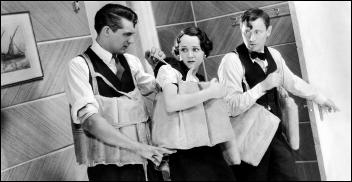
If you can manage to forget what it might have been considering its source you will likely enjoy it. And it’s not like Hollywood reserved this treatment for Ruric’s book, or have we forgotten Satan Met a Lady, the second version of The Maltese Falcon?
That said, once or twice toward the end of the film you get a glimpse of how Grant might have played Kells, and you have to at least think about what might have been, Fast One is a very violent book that reads more like it was written with a tommy gun than a typewriter.
They turned swiftly down Cherokee and a spurt of flame came out of a parked, close curtained limousine to meet them, lead thudded, bit into the side of the car. Borg stepped on the throttle, they plunged forward, past. Kells looked back at Granquist. She was lying with her eyes tightly closed and her face was very white. He put one arm back toward her and she rose suddenly to her knees, put her hands on his shoulder.
He smiled. “We’re all right, baby,†he said softly. “They build these cars in Detroit — that’s machine-gun country.â€
Machine gun country is where Ruric’s book would feel at home, if not the film based on it.
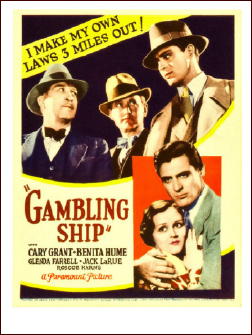
Note: The novel Fast One has been reviewed by Bill Pronzini some time back on this blog. Check it out here. And both the novel and the author are discussed in depth by Walker Martin in his review of The Complete Slayers, by Paul Cain. It’s worth your reading again, or for the first time, if you haven’t already.
November 14th, 2013 at 12:51 am
I’ve read FAST ONE by Paul Cain at least 3 times, most recently last year when I reviewed THE COMPLETE SLAYERS. He was one of the authors that got me interested in collecting the crime pulps like BLACK MASK, DIME DETECTIVE, and DETECTIVE FICTION WEEKLY. Back in the late 1960’s and early 1970’s I figured if an author as good as Paul Cain remains buried in the pulps, perhaps there were other hard-boiled writers that I might like almost as well as Hammett and Chandler.
As the recent collections by Altus Press show there definitely were other writers such as Fred Nebel, Raoul Whitfield, Norbert Davis, and others.
I’ve seen GAMBLING SHIP and as David Vineyard points out, it is an enjoyable movie and only suffers in comparison to the novel, FAST ONE. I would have to say that FAST ONE is in the running for the toughest, most hard-boiled novel. Certainly in the top ten and the ending is as downbeat as any film noir. A great crime novel.
November 14th, 2013 at 2:37 pm
For some reason I can’t explain, I wasn’t aware of this film until David sent me this review of it. It’s obviously must-see viewing, and luckily it looks as though I (and everyone else) can see it all, in installments, on YouTube.
November 14th, 2013 at 11:52 pm
Steve
The You Tube version is not a bad copy, but in downloading it be sure you get the right part 6 — one is just part 5 again — you can tell because both parts 5 and 6 have the same shot of Grant in a car, while the right one shows an office scene.
I can’t remember for sure, but I think it emerged on the fan convention circuit in the nineties along with Nebel’s Sleepers East(1932).
Walker
I first encountered Fast One through Bill Pronzini’s genre defining anthology The Hardboiled Detective. A bit later I noticed Gambling Ship listed in Maltin, and it sounded awfully close. Of course there was no Net then, but I found the film reviewed in the NYTimes on microfiche, and sure enough Ruric was listed as the source.
It’s taken me this long to see it.
Fast One was reprinted in hardcover in the seventies as part of a forgotten fiction project, and the extensive essay at the books beginning pretty much makes the same claim for it that you, Bill Pronzini, and I make.
I would have to nominate this as the toughest thing ever printed in Black Mask, and very likely the toughest novel to come out of the genre, yet Kells doesn’t emerge as a cartoon character, but a vulnerable human being.
It’s also a very well written novel, benefiting from Ruric’s cinematic savy so it reads much more modern than you might expect. It’s no where near as well known, but I’d rank it just below Hammett, Chandler, and Whitfield’s Death in the Bowl and Green Ice.
Though he was much less humorous, I always found Jonathan Latimer’s style recalled Ruric’s — perhaps that cinematic sense.
March 8th, 2020 at 4:08 pm
[…] Mystery*File delves into the movie’s source material: […]